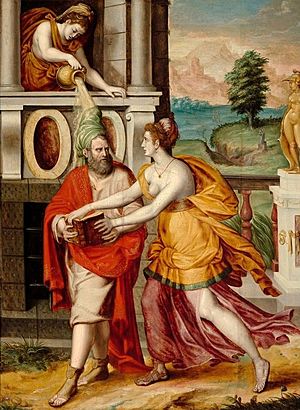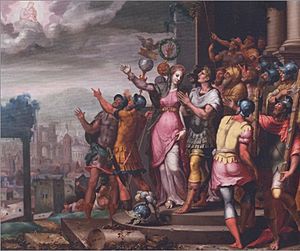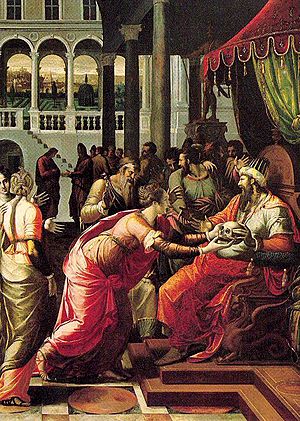Luca Penni facts for kids
Luca Penni (born around 1500–1504, died 1556) was an Italian painter from the 16th century. He is most famous for his work in France, where he was part of the First School of Fontainebleau. People often called him Le Romain, which means "the Roman".
Contents
Luca Penni's Early Life and Training
Luca Penni was born in Florence, Italy. His family were weavers, and his brothers, Gianfrancesco Penni and Bartolommeo Penni, also became painters. It seems Luca learned his painting skills from the famous artist Raphael in Florence and Rome.
In the late 1520s, Luca worked with his brother-in-law, Perino del Vaga, in Genoa. During this time, he started to develop his own unique painting style before moving to Fontainebleau.
Working for the French King
Luca Penni, along with other Italian artists like Rosso Fiorentino and Francesco Primaticcio, was invited to France by King Francis I of France. The king wanted them to decorate his beautiful Palace of Fontainebleau. These artists brought a bold, detailed, and elegant Italian Renaissance style to the palace.
Luca Penni was part of Primaticcio's team. He helped decorate areas like the pavillon des Poêles and the galerie d’Ulysse. He also created drawings for tapestries, which are woven pictures used to decorate walls. From 1537 to 1540, royal records show he was one of the top artists at the French court.
Meanwhile, Luca's brother Gianfrancesco Penni stayed in Rome and became a main assistant to Raphael. Another brother, Bartolommeo Penni, moved to England to work on Nonsuch Palace for King Henry VIII. He remained one of the foreign artists of the Tudor court.
Around 1546, Luca might have left France with an artist named Léon Davent. Many of Davent's prints from 1546 or 1547 are based on Luca Penni's designs. Davent made many etchings of Penni's work throughout the 1540s and early 1550s.
After King Francis I died in 1547, Penni moved to a street in Paris called rue de la Cerisaie. He kept working with printmakers, continuing his Fontainebleau style. He created art for new wealthy and middle-class clients. His art, including religious, mythological, and everyday scenes, became well-known through engravings by artists like Jean Mignon and Léon Davent. René Boyvin even engraved Penni's oil portrait of King Henry II of France. Sadly, Penni's original painting for The Resurrection of Lazarus is now lost. Luca Penni died in Paris.
Luca Penni's Artistic Style
Luca Penni's art was influenced by the famous artist Raphael and the unique style of Fontainebleau. Even though his ideas often came from Raphael's work, Penni's lines were clean and simple. This was a result of his years at Fontainebleau, where he worked on projects with Rosso and Primaticcio. His artistic journey actually led him to create a style that became known as French classicism, which grew out of Italian Mannerism.
Famous Works by Luca Penni

Here are some of Luca Penni's notable works:
- Battle of the Tupinamba (a drawing)
- Mars assisting Venus in her toilette (a drawing)
- Queen before a king holding a skull (oil painting)
- Augustus and the Tiburtine Sibyl, around 1550 (oil painting)
- Lamentation of Christ (oil painting)
- Socrates and Xanthippe (oil painting)
- Jesus Bearing the Cross (a drawing)
- Aeneas and the golden bough (a drawing)
- The Trojans washing the frozen body of Misenus and preparing his funeral pyre (a drawing)
- The Conversion of Saint Paul (a drawing)
- David beheading Goliath (a drawing)
- The Judgement of Paris (a drawing)
- Cassandra stopping Deiphobus from killing Paris, victor of the funerary games organised in his memory (two drawings)
- Battle in the palace of Priam (a drawing)
- The Trojan Horse being brought into Troy (a drawing)
- Pietà (a drawing)
- Alcinous receiving Ulysses (a drawing)
- Banqueting scene (a drawing)
- Polyphemus in love with Galatea (a drawing)
- Mars assisting Venus in her toilette (a drawing)
- Venus embracing Cupid (oil painting)
- Jupiter and Semele (a drawing)
- Venus asking Cupid to strike Pluto (a drawing)
- Renown driving a quadriga, in which are seated Victory and Abundance (a drawing for a medal)
- A queen before a king, holding a skull (a drawing)
- The Holy Women at the Tomb (a drawing)
Images for kids
See also
 In Spanish: Luca Penni para niños
In Spanish: Luca Penni para niños







